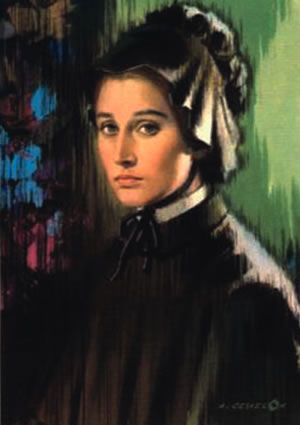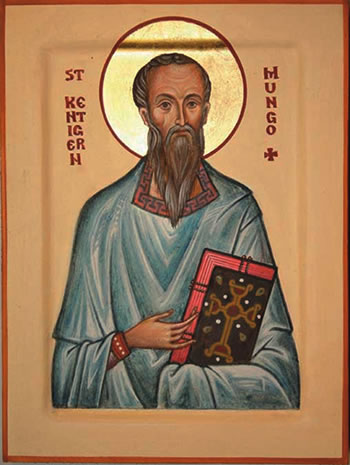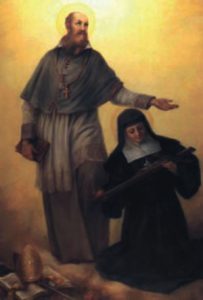January Saints
 Saint Elizabeth Ann Seton (1774-1821)
Saint Elizabeth Ann Seton (1774-1821)
Born in New York in 1774, Elizabeth Seton’s father was a well-known physician and her mother the daughter of an Anglican rector. Her mother died when she was three years old. Elizabeth’s unusual education and character formation were her father’s special concern. Even as a child, she delighted in prayer and in spiritual reading.
At age 19, Elizabeth married wealthy young William Seton, to whom she bore five children. While their early married life was extremely happy, great difficulty overcame them. Within four years, Will’s father died, leaving the young couple in charge of Will’s seven half-brothers and sisters as well as the family’s importing business. Both Will’s business and his health failed and he died of tuberculosis in 1803.
Elizabeth converted to Catholicism through the influence of an Italian family whose piety, virtue, love for one another, and charity impressed her greatly. She was received into the Catholic Church in 1805 and was promptly ostracised by her family and friends. She was forced by anti-Catholic bigotry to leave several jobs. A Sulpician priest was at the time looking to establish a Catholic girls’ school in Baltimore and suggested that Elizabeth start a religious community to take up this work. In June 1808 she opened St Joseph’s School for girls, the beginning of the Catholic system of parochial schools in America. On March 25, 1809, Elizabeth pronounced her vows of poverty, chastity and obedience, and from then on was called Mother Seton.
Her sisters were very active, establishing free schools, orphanages and hospitals. In addition to her responsibilities to the congregation, Mother Seton personally worked with the poor and sick, composed music, wrote hymns, and penned spiritual discourses. Although she was now afflicted with tuberculosis, she continued to guide her children, the Rule of the Sisterhood being formally ratified in 1812.
St Elizabeth was a charming and cultivated woman of determined character. Of all the attendant discouragements and difficulties she faced, the hardest to bear were interior to herself. For example, she detested having to exercise authority over others and she suffered much from bouts of spiritual aridity. For the last three years of her life, Elizabeth felt that God was getting ready to call her, and this gave her joy. She died in 1821 at the age of 46, the first native-born American to be canonised.
Saint Elizabeth, teach us the value of our Catholic faith.
(Source: Internet – various)
 Saint Kentigern
Saint Kentigern
(d. circa 603)
Saint Kentigern (or Mungo) lived during the 6th and 7th centuries and is the patron saint of the Church of Glasgow which he is supposed to have founded. He had a very disturbed life and on one occasion had to flee into Wales. He was eventually established as a bishop of the Cambrain region before settling and establishing his church in Glasgow.
Kentigern is associated with four symbols which represent some of his miracles, the bird, the tree, the bell and the fish, two of which are perpetuated on the arms of the city of Glasgow.
He is supposed to have died around 603. The truth is we don’t know when he died. The current Glasgow Cathedral is supposed to be built on the spot where he was laid to rest.
Saint Kentigern, help us to spread the Word of God to others.
(Source: A New Dictionary of the Saints, Donald Attwater. 1993 Burns & Oates, Kent; internet - various)
 Saint Francis de Sales (1567-1622)
Saint Francis de Sales (1567-1622)
Born of a noble family in Savoy in 1567, Francis was a student of law at Paris and Padua, but decided to become a priest, being ordained in 1593. He was sent as a missioner to the Protestants of Chablai, where he was notably unsuccessful. Succeeding to the see of Geneva in 1602, he established a seminary at Annecy, organised conferences and synods of his clergy, and insisted on simple preaching and religious instruction.
With Saint Frances de Chantal, he founded the Visitation Order of nuns. He was one of the finest bishops and most attractive men that Christianity had ever produced, and his effect on the indifferent and on Protestants was most marked. “The man who preaches with love,” he said, “preaches adequately against the heretics, even though he never utters a controversial word.”
He was the author of several famous written works and died in 1622.
Saint Francis, teach us the power of gentleness in our dealings with others.
(Source: A New Dictionary of the Saints, Donald Attwater. 1993 Burns & Oates, Kent)
 Entries(RSS)
Entries(RSS)